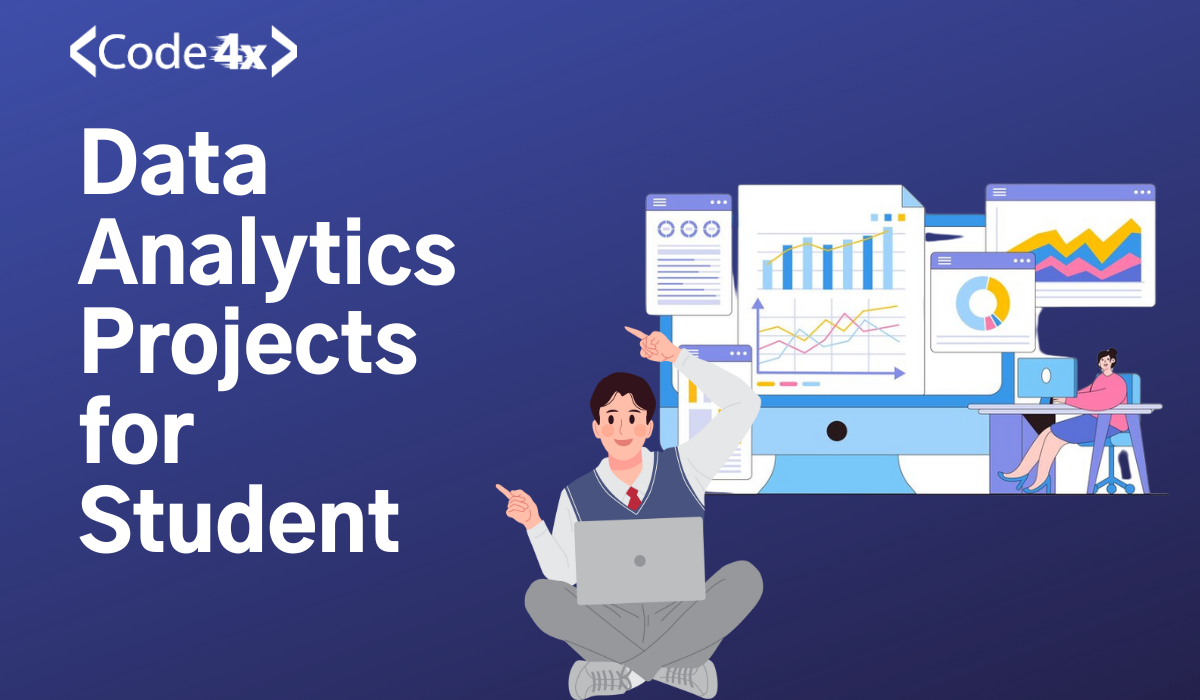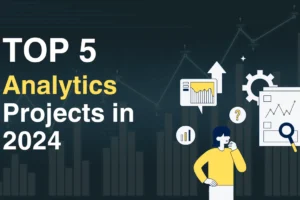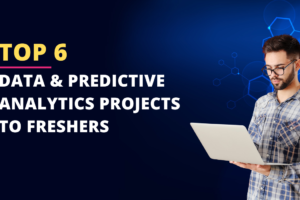
Best Data Analytics Projects for Student
Why Hands-on Data Analytics Projects are Essential for Students
As a final year student in engineering, IT, or a related field, you’re likely gearing up for placements in a dynamic job market. Data Analytics is a booming field, and equipping yourself with the right skills can give you a significant edge. But textbooks and lectures can only take you so far. Hands-on data analytics projects for students are the key to truly solidifying your understanding and showcasing your capabilities to potential employers.
Through data analytics projects for students, you get to:
- Apply theory to practice: Learning about algorithms is important, but using them to solve real-world problems is what sets you apart. Projects allow you to experiment, troubleshoot, and refine your approach in a practical setting.
- Build a strong portfolio: Having a portfolio filled with diverse data analytics projects for students demonstrates your technical skills and problem-solving abilities in a tangible way. It becomes a talking point during interviews that showcases your ability to deliver results.
- Develop essential tools: Working on data analytics projects for students often involves using programming languages like Python or R, data visualization tools like Tableau or Power BI, and data wrangling techniques. These skills are highly sought after by data-driven companies, and projects provide a platform to develop proficiency in them.
- Boost your confidence: Successfully completing data analytics projects for students gives you a sense of accomplishment and builds your confidence in your abilities. You’ll be able to approach interviews with the knowledge that you can tackle real-world data challenges.
Now, let’s dive into some project ideas that go beyond the usual suspects. These data analytics projects for students will challenge you and showcase your unique skillset:
Project 1: Analyzing Sensor Data for Smart Homes | Data Analytics Projects For Students
Use Case: Imagine a company developing smart home technology. Sensor data is collected from various devices like thermostats, light fixtures, and motion detectors. The goal is to analyze this data to gain insights into user behavior and optimize energy consumption.
Business Goal: Reduce energy usage in smart homes by identifying patterns and inefficiencies.
Input Data: Sample datasets containing sensor readings (temperature, light levels, etc.), timestamps, and user information (optional).
Steps to Perform:
- Data Cleaning and Preprocessing: Since sensor data can be noisy, you’ll need to identify and handle missing values, outliers, and inconsistencies.
- Exploratory Data Analysis (EDA): Analyze patterns in sensor readings based on time of day, day of week, and user behavior. Visualize trends using time series plots or heatmaps.
- Feature Engineering: Create new features from existing data. For example, calculate the average temperature for a specific timeframe.
- Anomaly Detection: Identify unusual spikes or dips in sensor readings that might indicate malfunctioning devices or unusual activity.
- Clustering: Group similar user behavior patterns to identify different segments (e.g., eco-conscious users, heavy energy consumers).
- Predictive Modeling (Optional): Develop a model to predict future energy consumption based on historical data and user behavior.
Project 2: Sentiment Analysis of Social Media Data | Data Analytics Projects For Students
Use Case: A marketing agency wants to understand public perception of a new product launch. They provide you with social media data (tweets, comments) related to the product.
Business Goal: Gauge public sentiment (positive, negative, neutral) towards the product to inform future marketing strategies.
Input Data: Sample social media data containing text content, timestamps, and user information (optional).
Steps to Perform:
- Data Cleaning and Preprocessing: Clean the text data by removing irrelevant characters, URLs, and mentions. Preprocess the text by converting it to lowercase and applying stemming or lemmatization techniques.
- Sentiment Lexicon Building (Optional): Create your own sentiment lexicon by identifying words and phrases associated with positive, negative, and neutral sentiment.
- Machine Learning Techniques: Train a machine learning model (e.g., Naive Bayes, Support Vector Machines) to classify tweets or comments based on sentiment. Evaluate the model’s performance using metrics like accuracy, precision, and recall.
- Topic Modeling (Optional): Identify the main topics discussed in social media conversations related to the product launch.
- Visualization: Create insightful visualizations (e.g., word clouds, sentiment distribution charts) to showcase the analysis results.
Project 3: Churn Prediction for a Streaming Service
Use Case: A subscription-based streaming service wants to identify users at risk of canceling their subscriptions.
Business Goal: Reduce customer churn by proactively engaging users who are likely to cancel.
Input Data: Sample customer data containing subscription details, viewing history, demographics, and payment information.
Steps to Perform:
- Data Exploration: Analyze user behavior patterns, such as the frequency and type of content they watch. Identify correlations between user characteristics and churn.
- Feature Engineering: Create new features from existing data that might be predictive of churn. For example, calculate the average watch time per month or the number of unique genres watched.
Project 4: Website Traffic Analysis for Personalized Recommendations
Use Case: An e-commerce website wants to personalize product recommendations for each visitor to improve conversion rates.
Business Goal: Increase sales by suggesting relevant products to website visitors based on their browsing behavior.
Input Data: Sample website clickstream data containing user ID, timestamps, product page views, and potentially other interaction data (add to cart, abandoned cart, etc.).
Steps to Perform:
- Data Cleaning and Preprocessing: Clean the clickstream data by identifying and handling invalid entries, missing values, and user sessions.
- Sessionization: Segment user clicks into individual browsing sessions based on timeouts or specific actions (e.g., page refresh).
- User Path Analysis: Analyze the sequence of pages visited by users within a session to understand browsing patterns. Techniques like Markov chains can be used to model user navigation behavior.
- Recommendation Engine Development: Develop a recommendation engine that leverages user browsing history and potentially other factors (e.g., purchase history, demographics) to suggest relevant products for each visitor. Collaborative filtering or content-based filtering techniques can be explored.
- A/B Testing: Test the effectiveness of your recommendation engine by comparing conversion rates for users shown personalized recommendations vs. a control group.
Project 5: Analyzing Public Transportation Data for Improved Efficiency
Use Case: A city transportation authority wants to optimize bus routes and schedules to reduce passenger wait times and improve overall network efficiency.
Steps to Perform:
- Data Acquisition: Public transportation authorities often release data on bus routes, schedules, passenger ridership, and GPS coordinates of bus locations. You might need to combine data from different sources.
- Data Cleaning and Preprocessing: Clean the data by identifying and handling missing values, outliers, and inconsistencies.
- Exploratory Data Analysis (EDA): Analyze patterns in bus ridership based on time of day, day of week, and specific bus routes. Identify routes with high passenger volume or long wait times.
- Route Optimization: Use techniques like network analysis or spatial clustering to identify opportunities for route optimization. This could involve merging routes, adjusting schedules, or adding new stops.
- Predictive Modeling (Optional): Develop a model to predict passenger demand at specific bus stops based on historical data and external factors (e.g., weather, special events). This information can be used for real-time scheduling adjustments.
- Visualization: Create insightful visualizations (e.g., heatmaps on a city map showing wait times, flow charts depicting passenger movement) to communicate your findings to stakeholders.
While textbooks and lectures provide a strong foundation, data analytics projects for students are the bridge between theory and real-world application. They allow you to experiment, make mistakes (in a safe environment!), and refine your skills in a way that simply memorizing facts cannot. This practical experience with data manipulation, analysis, and problem-solving using industry-standard tools is exactly what employers are looking for. By showcasing a portfolio of these data analytics projects for students, you demonstrate not just your book knowledge, but your ability to think critically, adapt to challenges, and translate data into actionable insights – qualities that will make you a standout candidate in today’s data-driven job market. So, roll up your sleeves, dive into these project ideas, and get ready to impress potential employers with your newfound data analytics prowess!



